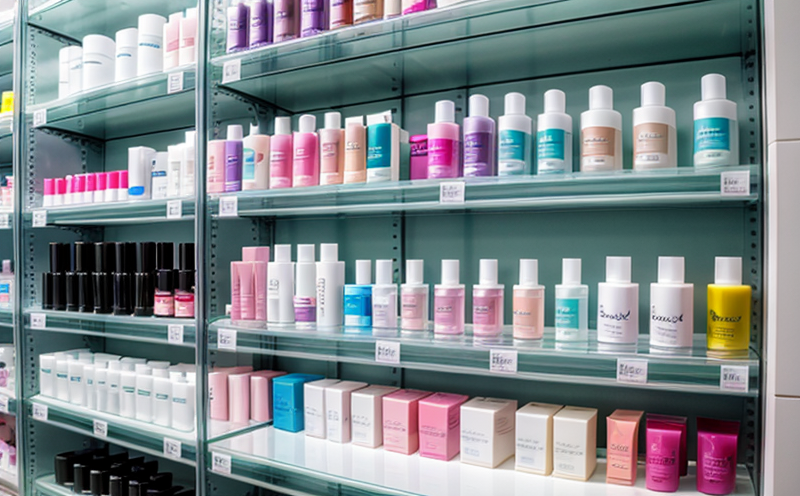Colorant Stability Testing in Cosmetic Products
The stability of colorants within cosmetic formulations is critical to ensure that products meet quality standards and consumer expectations. Colorants can be affected by various factors such as time, temperature, light, moisture, and other ingredients present in the formulation. This testing ensures that the colorants remain stable throughout the shelf life of the product, thereby maintaining consistent color appearance and preventing issues like fading or uneven distribution.
Understanding the stability of colorants is essential for quality managers, compliance officers, R&D engineers, and procurement specialists who need to ensure that their cosmetic products meet regulatory requirements. For instance, regulatory bodies such as the European Union and the US Food and Drug Administration (FDA) have specific guidelines regarding the use and safety of colorants in cosmetics.
The testing process involves exposing samples to controlled conditions that mimic real-world scenarios where stability could be compromised. This includes accelerated aging tests under high temperatures and humidity, photostability studies, and compatibility checks with other ingredients in the formula. By performing these tests early in the product development cycle, manufacturers can identify potential issues before they become costly problems during production.
Accurate measurement of colorant stability is achieved using advanced analytical techniques such as spectrophotometry and HPLC (High-Performance Liquid Chromatography). These methods allow for precise quantification of the colorants over time, providing valuable data on how well the formulation maintains its intended appearance. Additionally, rheological analysis may be conducted to assess changes in viscosity which can affect colorant distribution.
It is important to note that not all colorants behave similarly; some are more prone to degradation than others depending on their chemical structure and environmental exposure. Therefore, it is crucial for manufacturers to conduct thorough stability testing tailored specifically to the types of colorants used in each product formulation. This ensures compliance with global cosmetic regulations while also protecting brand reputation.
Failure to properly test colorant stability can lead to significant consequences including legal action due to non-compliance or substandard products that do not meet consumer satisfaction levels. By investing in comprehensive testing, companies can avoid these pitfalls and produce high-quality cosmetics that stand up to rigorous scrutiny both domestically and internationally.
Scope and Methodology
The scope of colorant stability testing encompasses several key areas aimed at evaluating the performance of colorants under different environmental conditions. The methodology typically includes accelerated aging tests, photostability assessments, compatibility checks with other ingredients in the formulation, and rheological analysis.
| Test Type | Description |
|---|---|
| Accelerated Aging Test | This involves exposing samples to elevated temperatures (e.g., 60°C) and humidity levels (RH >95%) for extended periods to simulate long-term exposure conditions. The objective is to observe any changes in colorant properties over time. |
| Photostability Assessment | Involves exposing samples to light sources such as xenon arc lamps or UV bulbs that mimic sunlight, aimed at assessing the resistance of colorants against photochemical reactions leading to degradation. |
| Compatibility Check | This step ensures that the chosen colorant does not interact adversely with other components in the formulation, potentially affecting its stability or effectiveness. Compatibility testing can be done through visual inspection and instrumental analysis if necessary. |
| Rheological Analysis | To understand how changes in viscosity might impact colorant distribution within the product matrix, rheological properties are measured using instruments like rotational viscometers. Changes in these parameters could indicate potential issues affecting overall product quality. |
The results from these tests provide critical insights into the stability of colorants across various aspects of cosmetic products' lifecycle. They help manufacturers make informed decisions about ingredient selection and formulation adjustments to ensure consistent performance throughout shelf life.
Benefits
- Ensures Regulatory Compliance: By conducting thorough colorant stability testing, companies can demonstrate adherence to international standards such as ISO 21790:2018 and FDA regulations regarding cosmetic ingredients. This helps avoid potential legal issues related to non-compliance.
- Enhances Consumer Trust: Consistent product quality builds trust among consumers who expect their favorite brands to deliver reliable performance consistently across all batches of a given product line.
- Promotes Product Integrity: Stable colorants contribute significantly towards maintaining the integrity and aesthetics of cosmetic formulations, ensuring that products continue to meet desired visual standards even after extended storage periods.
- Saves Costs: Early detection of unstable colorants allows for corrective actions during development stages rather than discovering costly mistakes post-launch when recalls or rework are inevitable.
- Increases Shelf Life Expectancy: Effective stability testing can extend the shelf life of cosmetic products by identifying and addressing factors that contribute to premature degradation, thereby offering better value for money to customers.
Through meticulous colorant stability testing, manufacturers can achieve a balance between aesthetics and functionality, ensuring their products remain appealing and effective over time. This not only enhances customer satisfaction but also supports sustainable business practices by minimizing waste associated with expired or compromised products.
Industry Applications
The importance of colorant stability testing extends beyond mere compliance; it plays a pivotal role in ensuring the quality and safety of cosmetic products. In the industry, this service finds application across various segments including personal care brands, pharmaceutical companies producing topical medications, and even niche markets like organic cosmetics.
For instance, in the case of personal care brands, accurate colorant stability testing ensures that their signature shades remain vibrant and true to form despite prolonged exposure to various environmental factors. Pharmaceutical companies benefit greatly from this service too as they strive to maintain consistent therapeutic efficacy alongside appealing packaging designs. Meanwhile, organic cosmetics manufacturers leverage these tests to uphold strict standards set forth by certification bodies like USDA Organic or ECOCERT.
Regardless of the segment, all stakeholders involved recognize that robust colorant stability testing is integral to delivering high-quality products consistently across different markets worldwide. It enables brands to build strong reputations based on reliability and innovation while fostering long-term customer loyalty through dependable offerings.





